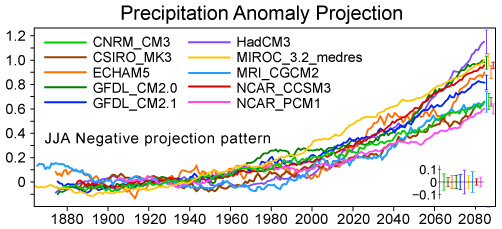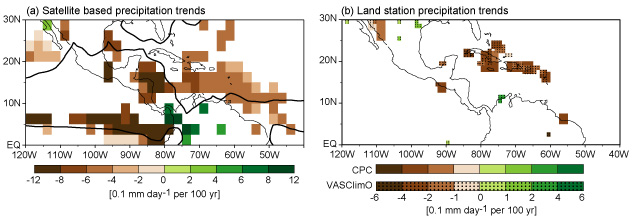· Related model results for the Caribbean/Central-American region
·The Upped-ante Mechanism and the Anomalous Gross Moist Stability (Rich-get-richer) Mechanism
Tropical drying trends in global warming models and observations
Climate models agree on tropical drying amplitudes under global warming, and on a drier Caribbean-Central American region(see also: PNAS paper links)
Precipitation changes associated with global warming simulations have proven much more difficult to characterize and corroborate than surface temperature changes. Analysis of an ensemble of coupled GCMs from the IPCC 4AR shows large inter-model agreement on a measurement of the overall amplitude of the precipitation decreases that occur at the margins of the convective zones, with percent error bars of magnitude similar to those for the tropical warming itself (Fig. 1). This agreement appears to be unprecedented for a precipitation-related global warming quantity. There is also general agreement on increases in precipitation near the centers of convective zones. Two related mechanisms hypothesized to be responsible for these changes have been previously identified in earlier publications by this research group: the "upped-ante" mechanism for drought tendency and the "anomalous gross moist stability" or "rich-get-richer" mechanism.

The models disagree on the exact locations of convective zones, and thus on the locations of precipitation changes for global warming scenarios. However, one drying zone with high agreement among models is the Caribbean-Central American region in summer, with a majority of models forecasting a significant trend (the precipitation reduction in late 21st Century in June-July-August is about 25% for the median model). Examination of four observational rainfall data sets reveals a significant drying trend in the same region (Fig. 2). In the models, the date at which this trend becomes statistically significant ranges from the mid-1990s to 2050s, implying caution in attributing the observed trend to anthropogenic global warming rather than natural decadal variability.
Overall, these results suggest that substantial regional changes in tropical precipitation will accompany global warming. The Caribbean-Central American region serves as an example of a region where models achieve agreement at the local level, although there is a clear need to improve model agreement on other regions of probable change.
